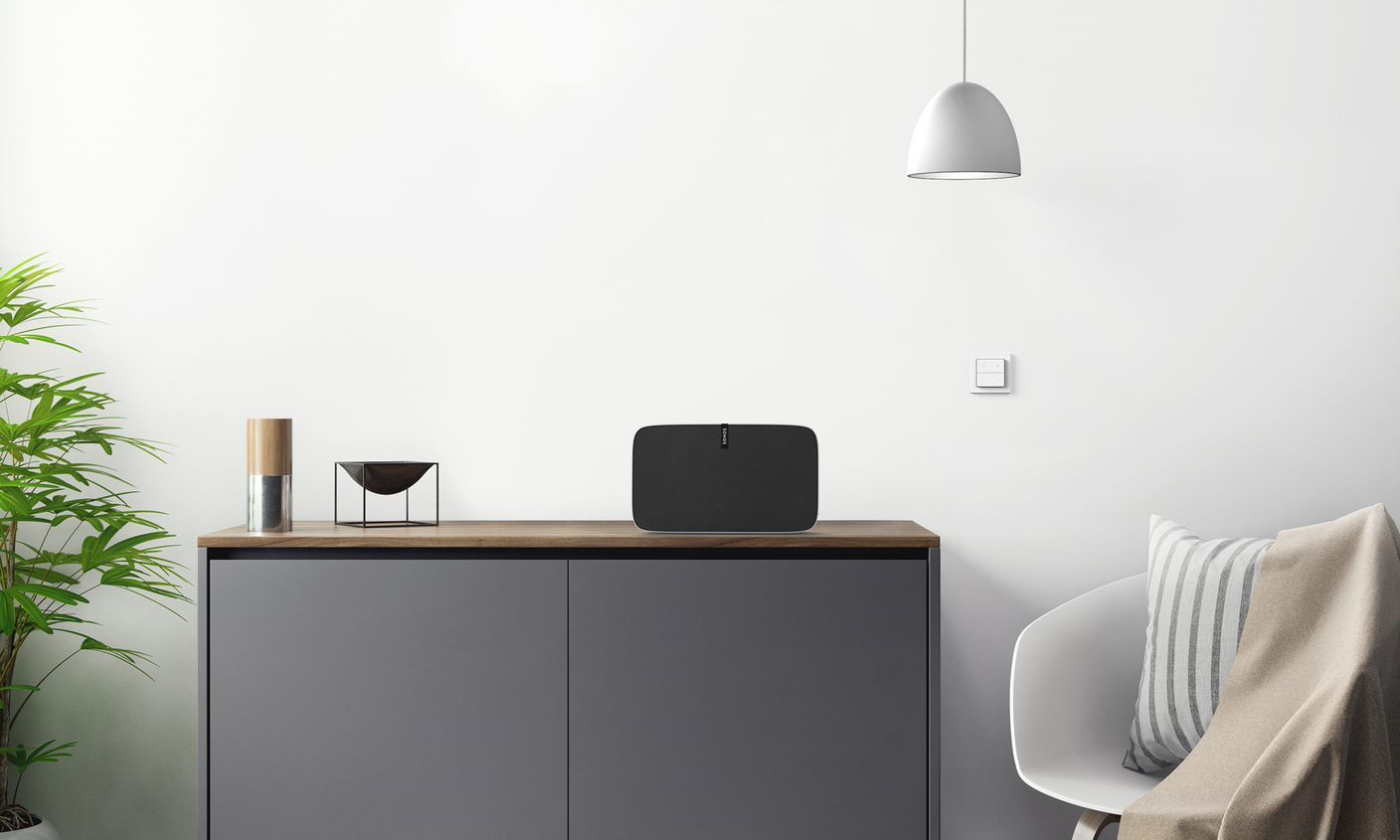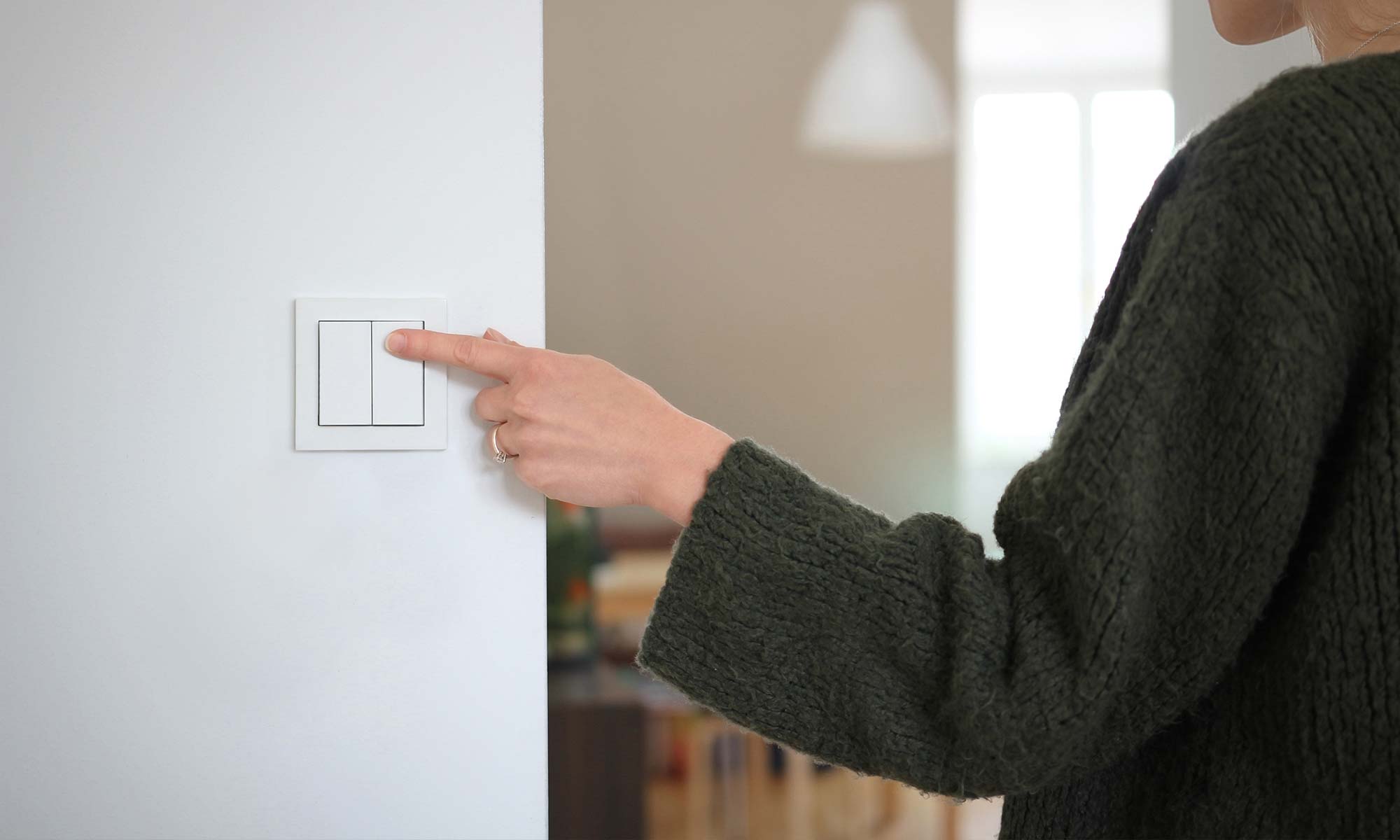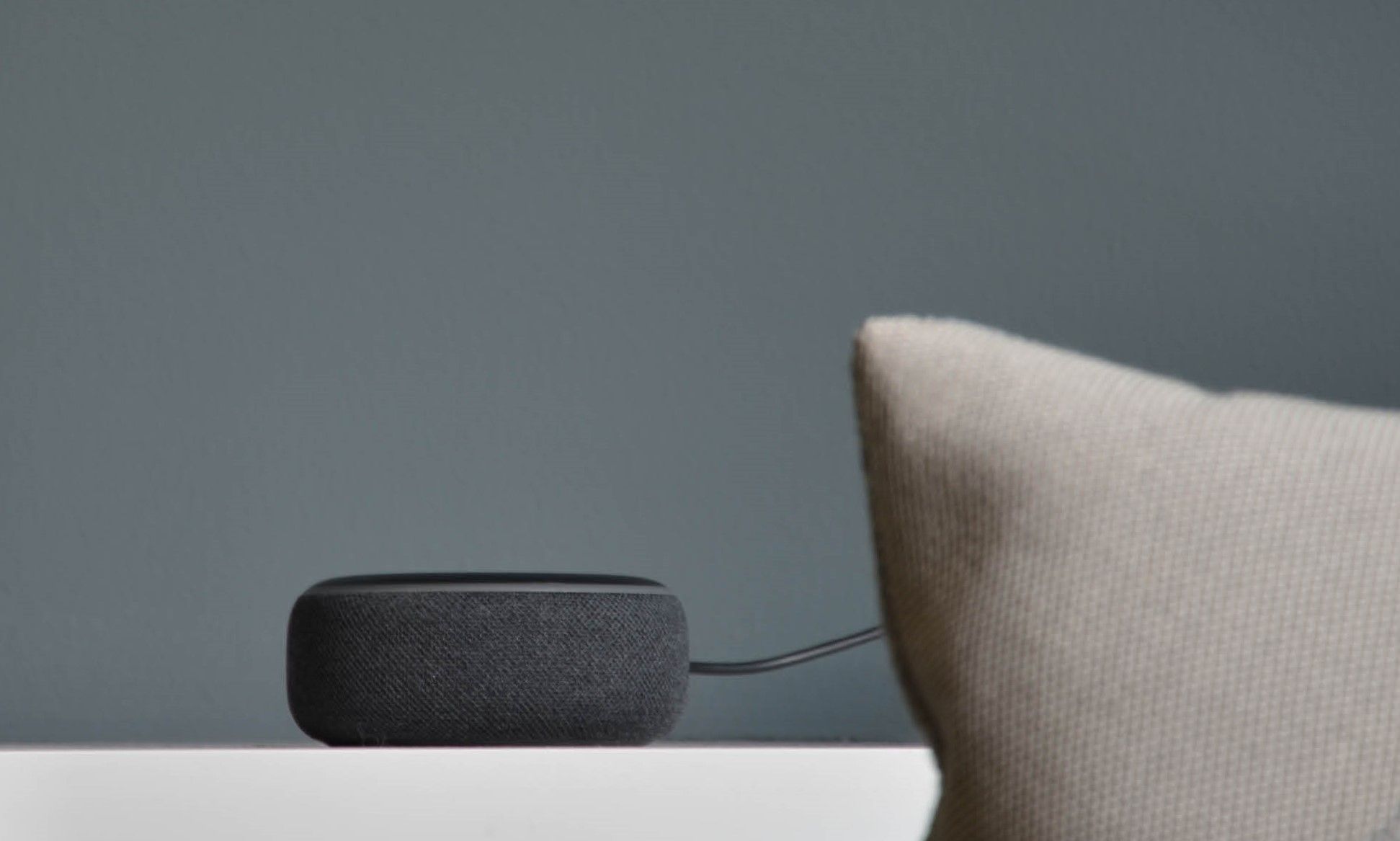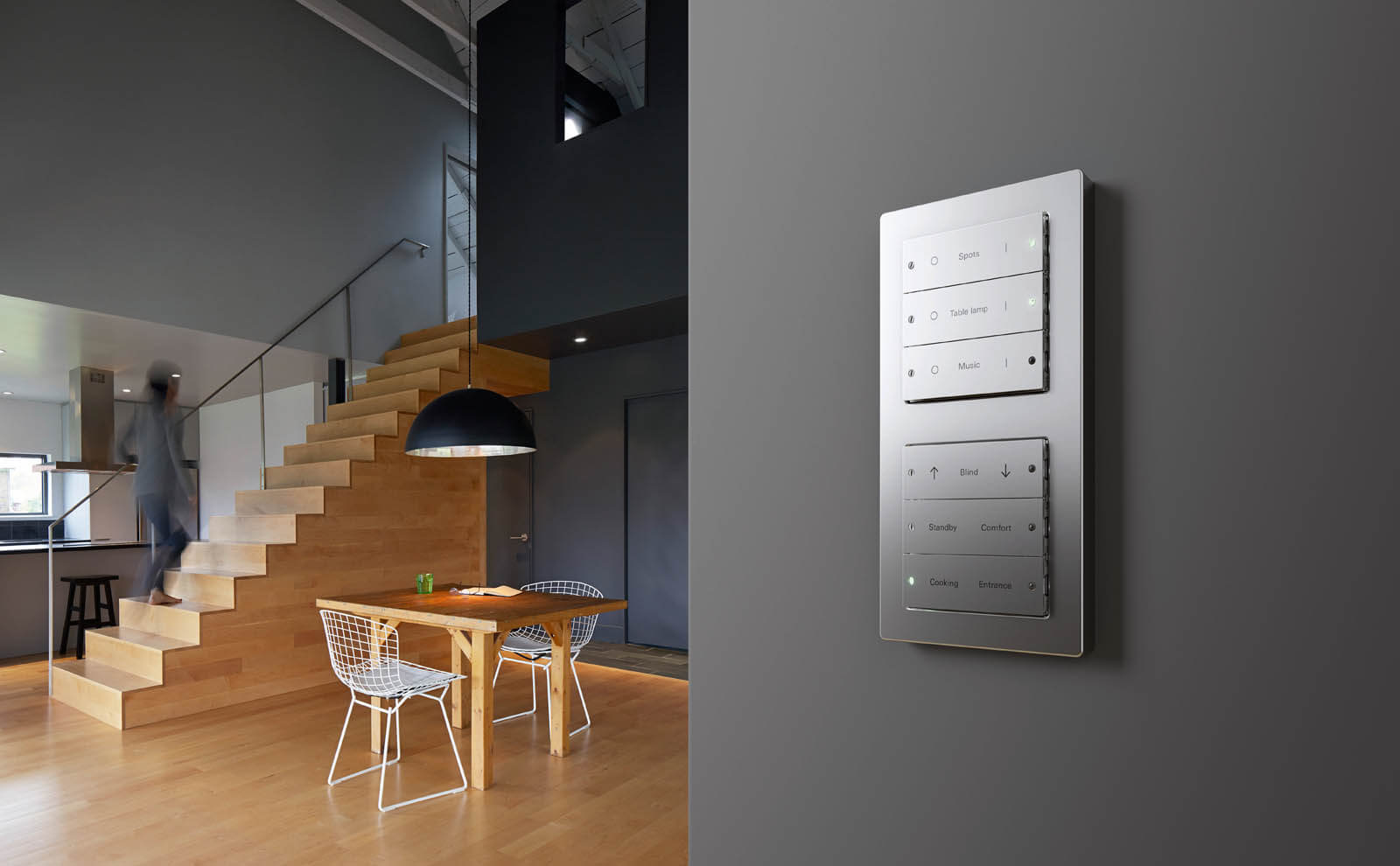
Lowering the blinds while driving in your car, turning out the heating before coming home, or dimming the lights with a simple utterance: Smart Home control offers countless options. But how does it all work – and what’s possible in apartments or older buildings? This article explains everything you need to know before getting started.
Whether you’re renting a flat or building your own house – technology makes daily routines easier at every turn. By automating functions such as blind, lighting, or heating, you can take your living comfort to a whole new level. What that may look like depends mainly how you control your Smart Home: from pushbutton sensors and touch panels to apps and voice assistants, it’s all about creating an intuitive experience that allows for maximum flexibility.
1. Smart Home control for new builds
You’re about to build your very own home? Then this is the perfect time to think about integrating a smart network. A KNX system ranks highest in terms of functionality, but it usually requires extra cabling. If you have it installed right away, you won’t need to worry about walls being pried open later on.
You’re about to build your very own home? Then this is the perfect time to think about integrating a smart network. A KNX system ranks highest in terms of functionality, but it usually requires extra cabling. If you have it installed right away, you won’t need to worry about walls being pried open later on.
KNX is the international standard for connected building technology. In line with that standard, Gira offers devices designed specifically for the control of KNX Smart Homes. The Gira pushbutton sensor 4, for example, covers up to eight individual functions that you can store and activate with a single tap. This includes not only lights, blinds, and heating, but also smart household appliances or entertainment systems. If you’re looking for a simpler solution, you can use the Gira button for KNX instead. Don’t be fooled by its understated appearance though: the button may seem like a regular light switch, but it can actually store and activate up to four different functions as well. Another benefit for lovers of interior design: the button for KNX is part of the Gira System 55, which means you can choose from a variety of frames in all sorts of colours and materials.
2. Smart Home control for retrofittings
You’ve already moved into your new home or live in an older building? In that case, we recommend a wireless solution such as the Gira System 3000 or Gira KNX RF. Gira System 3000 is the right choice if you want to focus on the most essential functions:
It doesn’t require extra cabling (as opposed to conventional KNX networks) and can therefore be retrofitted easily – even for a smart apartment. There are three options to control your devices: automated time schedules, a Bluetooth app, or operating elements such as the Gira System 3000 touch top unit. The latter has a touch-sensitive surface that enables you to precisely adjust the blinds’ position or dim the lights with a single finger swipe.
If you want to take Smart Home control one step further – and include features such as remote access via app – the Gira KNX RF system will do the trick. Since it relies on radio frequency (short RF), it works without extra cabling as well. All you need is a regular 230 V installation for switches and socket outlets. Your electrician will then mount the Gira KNX RF top units onto the same functional inserts used for the Gira System 3000. With the battery-operated Gira RF pushbutton sensor for KNX, you won’t even need a power supply line behind the wall: the unit can be placed on virtually any surface, including furniture or glass panes. In addition, mobile hand-held transmitters allow you to control your Smart Home from any room.
3. Smart Home control panels with special features
To keep an overview of everything that goes on in your KNX or KNX RF Smart Home, you can also rely on the Gira G1. Mounted on the wall, it serves as a central unit for all your connected functions and devices. The digital touch-sensitive display makes it easy to check or adjust the current settings via tap or swipe. Likewise, you can program complex scenes or schedule a presence simulation for times when your house is empty.
For those who don’t want to install a complete system right away, the Friends of Hue smart switch offers a convenient alternative. Developed by the Berlin-based startup Senic in collaboration with Gira, it requires neither cabling or batteries. Instead, it is based on EnOcean technology, which means you generate enough energy by simply pressing the switch. All you need for this kind of Smart Home control are Philips Hue lamps and a Hue Bridge. You can then connect your lights via app:
For those who don’t want to install a complete system right away, the Friends of Hue smart switch offers a convenient alternative. Developed by the Berlin-based startup Senic in collaboration with Gira, it requires neither cabling or batteries. Instead, it is based on EnOcean technology, which means you generate enough energy by simply pressing the switch. All you need for this kind of Smart Home control are Philips Hue lamps and a Hue Bridge. You can then connect your lights via app:
Select „Senic Friends of Hue switch”.
Follow the instructions of the manual to configure your settings.
Your individual setup might thus turn out like this, for instance:
Top right: switch on lights (wake-up light / bedroom)
Bottom right: switch on lights (night light / bedroom)
Top right hold: dim lights (bedroom)
Bottom right hold: switch off lights (bedroom)

4. Smart Home control via app
Ever forget to turn off the lights or heating before leaving your house? That won’t be a problem with a Gira KNX system. Depending on which server you have installed, there are two apps available:
Gira Smart Home app (compatible with the Gira X1 server)
Using your smartphone or tablet, you can control your Smart Home from literally anywhere – whether you’re out running errands, working at the office, or on vacation I another country. The security module Gira S1 thereby ensures that your personal data remain protected against unauthorised access at all times.
5. Smart Home control via voice command
Last but not least, there’s one more option that does not even require a smartphone: voice assistants enable you to stay in charge in the most intuitive way possible. Thanks to Alexa or the Google Assistant, you can literally tell your house what to do – and your wish will be granted instantly. Home automation with Alexa-controlled devices, for example, might look something like this:
“Alexa, turn off the bathroom lights!”
“Alexa, lower all blinds!”
The same goes for entertainment systems, e.g. playing your favourite music, or activating complex scenes that involve several functions at once. Voice control in Smart Homes thus not only makes life more comfortable – it also makes this kind of comfort accessible for elderly or physically impaired people.




